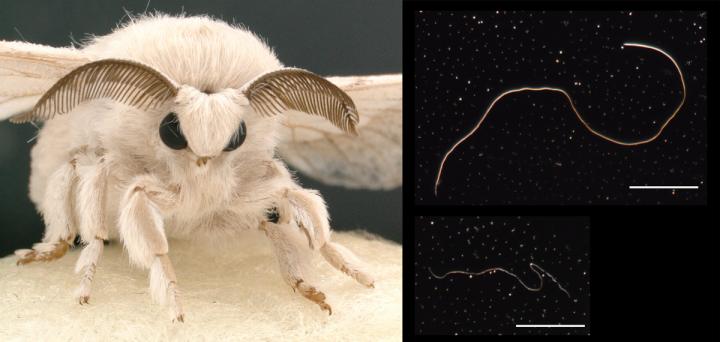
Credit: NIBB
Some animals form characteristic infertile spermatozoa called parasperm, which differ in size and shape compared to fertile sperm produced by single males. Species that have been reported to produce parasperm include snails, cottoid fish, moths and butterflies. Moths and butterflies produce fertile eupyrene sperm and anucleate non-fertile parasperm, which are known as apyrene sperm. A research team at the National Institute for Basic Biology in Japan has identified the gene involved in the formation of the apyrene sperm and has revealed the important function of the apyrene sperm in fertilization using the silk moth, Bombyx mori.
A member of the research team, Dr. Hiroki Sakai said, “Parasperm has been discovered in multiple animals despite its inability to be fertilized itself. From this, there is a possibility that parasperm may play an important role in fertilization.” Although many morphological observations and ecological surveys have been conducted on parasperm, genes involved in the formation of parasperm have not been identified in any species.
The researchers found that Sex-lethal (Sxl), which is a widely studied key sex determination gene in the fruit fly Drosophila melanogaster, is an essential gene for the formation of apyrene sperm in the silk moth “The Sxl gene plays an important role in female determination in the fruit fly. We are surprised that the gene was involved in the formation of non-nucleated sperm.” Dr. Sakai said.
The research group has created a silk moth whose Sxl gene function has been inhibited by the genome editing technology. As a result, they demonstrated that this silk moth could not form accurate apyrene sperm. Furthermore, the mating experiment using Sericology techniques revealed that its eupyrene sperm is normal. Based on this, it was revealed that Sxl is required for the formation of apyrene sperm.
Silk moth males, whose Sxl gene does not work, cannot produce future generations because they cannot produce apyrene sperm. Why can’t they reproduce without apyrene sperm? The research team has clearly shown that apyrene sperm is required for the eupyrene sperm migration in the female organs.
The leader of the research team, Prof. Niimi said, “The significance of this study is that it is the first time that specific genes required for parasperm formation have been identified. Moreover, we demonstrated that parasperm is necessary for eupyrene sperm migration in female organs. The results indicate that anucleate parasparam, while appearing less important in fertilization actually are so, may have a major impact on future sperm research in animals.
###
These results of the study will be published on the week of April 29, 2019 in Proceedings of the National Academy of Sciences of the United States of America.
Proceedings of the National Academy of Sciences of the United States of America
“Dimorphic sperm formation by Sex-lethal” by Hiroki Sakai, Hiroyuki Oshima, Kodai Yuri, Hiroki Gotoh, Takaaki Daimon, Toshinobu Yaginuma, Ken Sahara, Teruyuki Niimi
DOI: 10.1073/pnas.1820101116 (https:/
Media Contact
NIBB Office of PR
[email protected]
Related Journal Article
http://dx.




